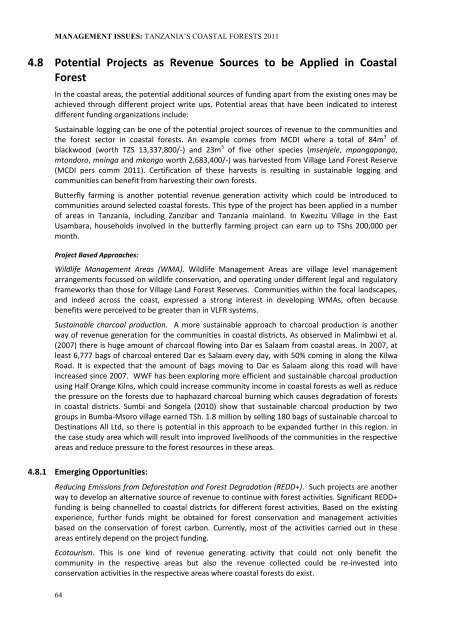Neil D. Burgess, Paul Harrison, Peter Sumbi, James Laizer, Adam ...
Neil D. Burgess, Paul Harrison, Peter Sumbi, James Laizer, Adam ...
Neil D. Burgess, Paul Harrison, Peter Sumbi, James Laizer, Adam ...
Create successful ePaper yourself
Turn your PDF publications into a flip-book with our unique Google optimized e-Paper software.
MANAGEMENT ISSUES: TANZANIA’S COASTAL FORESTS 2011<br />
4.8 Potential Projects as Revenue Sources to be Applied in Coastal<br />
Forest<br />
In the coastal areas, the potential additional sources of funding apart from the existing ones may be<br />
achieved through different project write ups. Potential areas that have been indicated to interest<br />
different funding organizations include:<br />
Sustainable logging can be one of the potential project sources of revenue to the communities and<br />
the forest sector in coastal forests. An example comes from MCDI where a total of 84m 3 of<br />
blackwood (worth TZS 13,337,800/-) and 23m 3 of five other species (msenjele, mpangapanga,<br />
mtondoro, mninga and mkongo worth 2,683,400/-) was harvested from Village Land Forest Reserve<br />
(MCDI pers comm 2011). Certification of these harvests is resulting in sustainable logging and<br />
communities can benefit from harvesting their own forests.<br />
Butterfly farming is another potential revenue generation activity which could be introduced to<br />
communities around selected coastal forests. This type of the project has been applied in a number<br />
of areas in Tanzania, including Zanzibar and Tanzania mainland. In Kwezitu Village in the East<br />
Usambara, households involved in the butterfly farming project can earn up to TShs 200,000 per<br />
month.<br />
Project Based Approaches:<br />
Wildlife Management Areas (WMA). Wildlife Management Areas are village level management<br />
arrangements focussed on wildlife conservation, and operating under different legal and regulatory<br />
frameworks than those for Village Land Forest Reserves. Communities within the focal landscapes,<br />
and indeed across the coast, expressed a strong interest in developing WMAs, often because<br />
benefits were perceived to be greater than in VLFR systems.<br />
Sustainable charcoal production. A more sustainable approach to charcoal production is another<br />
way of revenue generation for the communities in coastal districts. As observed in Malimbwi et al.<br />
(2007) there is huge amount of charcoal flowing into Dar es Salaam from coastal areas. In 2007, at<br />
least 6,777 bags of charcoal entered Dar es Salaam every day, with 50% coming in along the Kilwa<br />
Road. It is expected that the amount of bags moving to Dar es Salaam along this road will have<br />
increased since 2007. WWF has been exploring more efficient and sustainable charcoal production<br />
using Half Orange Kilns, which could increase community income in coastal forests as well as reduce<br />
the pressure on the forests due to haphazard charcoal burning which causes degradation of forests<br />
in coastal districts. <strong>Sumbi</strong> and Songela (2010) show that sustainable charcoal production by two<br />
groups in Bumba-Msoro village earned TSh. 1.8 million by selling 180 bags of sustainable charcoal to<br />
Destinations All Ltd, so there is potential in this approach to be expanded further in this region. in<br />
the case study area which will result into improved livelihoods of the communities in the respective<br />
areas and reduce pressure to the forest resources in these areas.<br />
4.8.1 Emerging Opportunities:<br />
Reducing Emissions from Deforestation and Forest Degradation (REDD+). Such projects are another<br />
way to develop an alternative source of revenue to continue with forest activities. Significant REDD+<br />
funding is being channelled to coastal districts for different forest activities. Based on the existing<br />
experience, further funds might be obtained for forest conservation and management activities<br />
based on the conservation of forest carbon. Currently, most of the activities carried out in these<br />
areas entirely depend on the project funding.<br />
Ecotourism. This is one kind of revenue generating activity that could not only benefit the<br />
community in the respective areas but also the revenue collected could be re-invested into<br />
conservation activities in the respective areas where coastal forests do exist.<br />
64

















